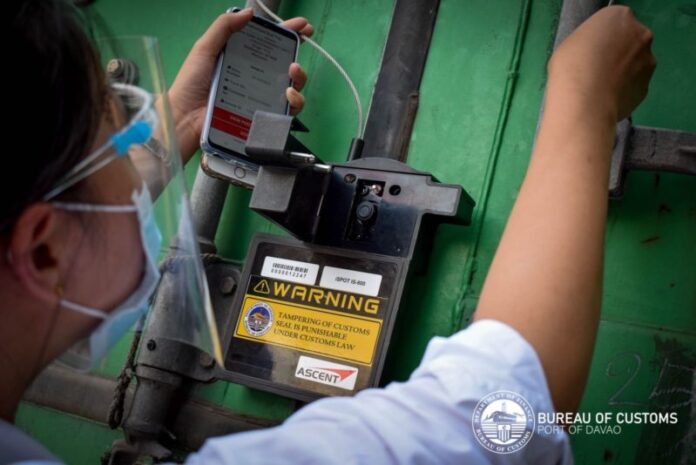-
The Bureau of Customs Electronic Tracking of Containerized Cargo System will be implemented on exports of economic zones and customs bonded warehouses in all ports by October 15
-
Exports from ecozones and CBWs with EX2 and EX4 type of declaration will be required by the electronic-to-mobile system to book in the E-TRACC booking platform
-
In case BOC is understaffed, authorized personnel from Ascent Solutions Philippines may be allowed to seal or unseal the ECS under the supervision of the appropriate BOC offices
The Bureau of Customs (BOC) Electronic Tracking of Containerized Cargo (E-TRACC) System will be implemented on exports of economic zones and customs bonded warehouses (CBW) in all ports by October 15.
This, after a new BOC order directed the implementation of the E-TRACC System on ports that had previously sought its postponement on ecozones and CBW exports.
Assessment and Operations Coordinating Group (AOCG) Memo No. 336-2022, dated October 7 and signed by AOCG deputy commissioner Edward James Dy Buco, provided clarification on the implementation of the E-TRACC System on ecozone and CBW exports. The order took immediate effect.
Dy Buco directed concerned offices to ensure containerized goods for export adhere to Customs Memorandum Order No. 04-2020 implementing the E-TRACC System and to CMO 17-2022, which integrates E-TRACC System with the Electronic-to-Mobile (E2M) System.
The memo noted that export declarations covering containerized export shipments from ecozones and CBWs with modes of declaration XE2 (export with raw material tax break) and XE4 (export shipments of Board of Investments-registered companies under customs bonded warehouse (CBWs) should comply with AOCG Memo No. 493-2021 and AOCG Memo No. 45-2022.
AOCG Memo No. 493-2021 provides guidelines on E-TRACC System implementation in ecozones while AOCG Memo No. 45-2022 provides rules on implementation of the same system on import and export cargoes for CBWs.
Exports from ecozones and CBWs with EX2 and EX4 types of declaration should be required by the E2M System to book in the E-TRACC booking platform, according to the order.
The E2M System will automatically validate the entry number and bill of lading. Bookings with the wrong entry number and/or bill of lading will be rejected and get an appropriate error message, the memo said.
Based on CMO 04-2020, when stuffing of a container is done, the export examiner or authorized customs officer should affix the electronic customs seal (ECS) to the container. Other seals as may be required should be affixed by authorized personnel under the supervision of the examiner or authorized customs officer.
The ECS is a GPS-enabled sealing device or lock that is capable of physically securing a cargo and providing real time location information.
On the unsealing of the ECS, authorized personnel of the Customs Container Control Division (CCCD) or its equivalent office should remove/disarm the ECS affixed to the container.
In case of inadequate number of BOC personnel, however, the authorized personnel of the E-TRACC System accredited service provider – Ascent Solutions Philippines Inc. – may be allowed to seal or unseal the ECS under the supervision of the Piers and Inspection Division, CCCD, or equivalent units of BOC.
BOC export examiners/appraisers or any authorized customs officer involved in the clearance procedures for exports should not process the export declaration-single administrative documents without the required E-TRACC booking.
E-TRACC is a Web-based system launched in 2020 to track the inland movement of containerized cargoes during transit and transfer to other customs territories and facilities. It allows BOC to track, monitor, and audit the location and condition of cargoes, as well as receive real-time alarms on diversion and tampering of cargoes.
Under CMO No. 04-2020, an ECS is required during the transfer of cargo to a container yard/container freight station or other customs facilities and warehouses; transit of cargo bound for free zones, inland customs offices, depots, or terminals; transit to CBWs; export of cargo from free zones, inland customs offices, depots or terminals, and CBWs to port of loading; and transfer of shipments subject to further verification or monitoring.
All container vans covered by CMO 04-2020 should be affixed with an ECS before being cleared to depart from the starting point or point of discharge for the voyage to the end point or point of destination.
Except when warranted under CMO 04-2020, customs cargo clearance must be fully completed before any shipment can be sealed with an ECS.
Several memos have been issued since 2020 on the gradual inclusion in the system of various economic zones, freeports, and collection districts, and for imports, interisland shipments, and CBWs. BOC also held public consultations on the proposed implementation of E-TRACC in all airports of entry.
Exporters and port users, however, had earlier recommended the suspension of E-TRACC System implementation on exports, saying it is unnecessary and will cause delays and additional costs.
The Customs Bonded Warehouse Operators Confederation Inc. and Philippine Exporters Confederation Inc. had earlier said in position papers to BOC that they deem “unnecessary and unreasonable” the implementation of E-TRACC for exports due to various reasons, such as export cargoes are destined for specific markets and are not likely to be diverted. – Roumina Pablo





